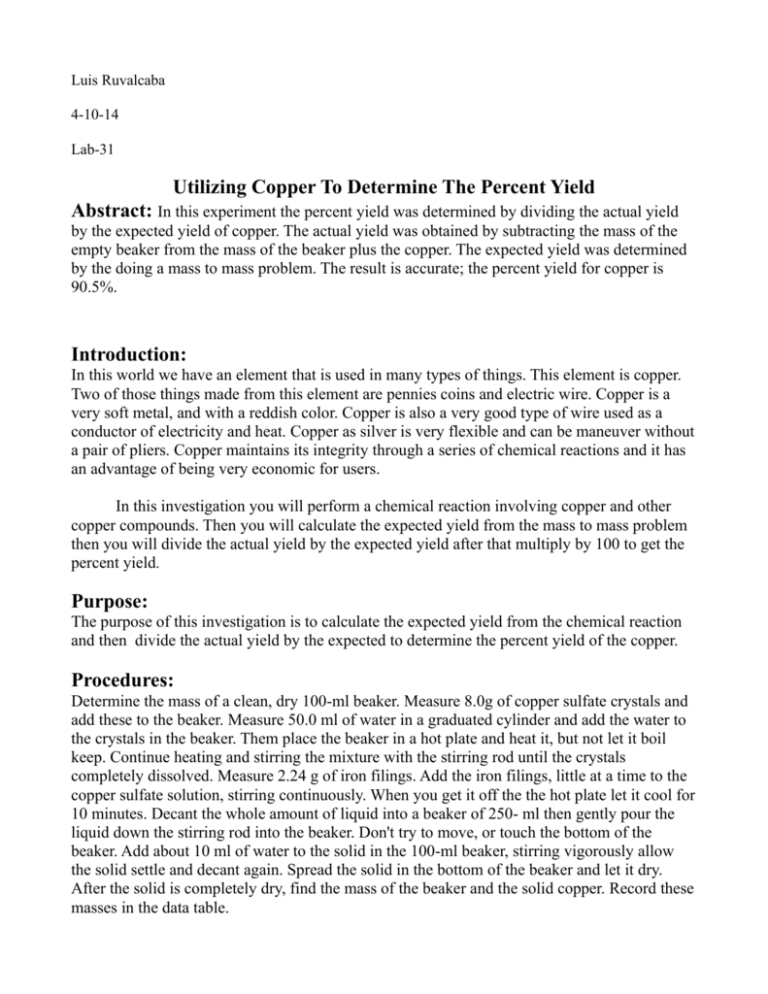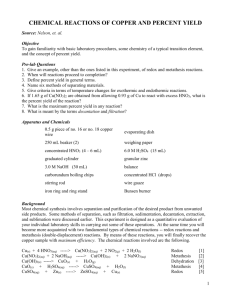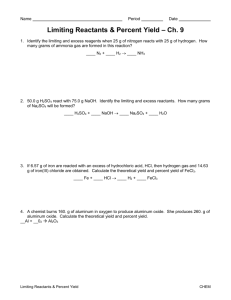Utilizing Copper To Determine The Percent Yield Introduction
advertisement

Luis Ruvalcaba 4-10-14 Lab-31 Utilizing Copper To Determine The Percent Yield Abstract: In this experiment the percent yield was determined by dividing the actual yield by the expected yield of copper. The actual yield was obtained by subtracting the mass of the empty beaker from the mass of the beaker plus the copper. The expected yield was determined by the doing a mass to mass problem. The result is accurate; the percent yield for copper is 90.5%. Introduction: In this world we have an element that is used in many types of things. This element is copper. Two of those things made from this element are pennies coins and electric wire. Copper is a very soft metal, and with a reddish color. Copper is also a very good type of wire used as a conductor of electricity and heat. Copper as silver is very flexible and can be maneuver without a pair of pliers. Copper maintains its integrity through a series of chemical reactions and it has an advantage of being very economic for users. In this investigation you will perform a chemical reaction involving copper and other copper compounds. Then you will calculate the expected yield from the mass to mass problem then you will divide the actual yield by the expected yield after that multiply by 100 to get the percent yield. Purpose: The purpose of this investigation is to calculate the expected yield from the chemical reaction and then divide the actual yield by the expected to determine the percent yield of the copper. Procedures: Determine the mass of a clean, dry 100-ml beaker. Measure 8.0g of copper sulfate crystals and add these to the beaker. Measure 50.0 ml of water in a graduated cylinder and add the water to the crystals in the beaker. Them place the beaker in a hot plate and heat it, but not let it boil keep. Continue heating and stirring the mixture with the stirring rod until the crystals completely dissolved. Measure 2.24 g of iron filings. Add the iron filings, little at a time to the copper sulfate solution, stirring continuously. When you get it off the the hot plate let it cool for 10 minutes. Decant the whole amount of liquid into a beaker of 250- ml then gently pour the liquid down the stirring rod into the beaker. Don't try to move, or touch the bottom of the beaker. Add about 10 ml of water to the solid in the 100-ml beaker, stirring vigorously allow the solid settle and decant again. Spread the solid in the bottom of the beaker and let it dry. After the solid is completely dry, find the mass of the beaker and the solid copper. Record these masses in the data table. Results: Mass of empty beaker Mass of beaker plus copper Actual yield of copper Expected yield of copper Percent yield of copper 49.1 Grams 51.6 Grams 2.3 Grams 2.54 Grams 2.3/2.54 *100% = 90.5% Conclusion: When we added the iron to the copper sulfate a new reactant was formed the copper went alone and the iron and sulfate became Feso4. It never passed to my mind that the expected yield was going to be very similar to expected yield and It was similar. I feel confident about what the percent yield we obtain by dividing the actual yield by the expected yield because I have done other percent yield problem before. For me and my partner the results we got were accurate. By doing the mass to mass problem I determined the expected yield. It gave me an idea of how much the actual yield could be. Am pretty sure that most of my classmates got a similar results the we obtained by dividing the actual yield by the expected yield and then multiplying it by 100 %. Discussion: The last result that we obtained for the actual yield of copper was 0.2 grams less than we got from the first time. When we were adding the iron filings to the copper sulfate we dropped some of the 2.4 grams we were supposed to add in. Once we add the iron filings I was the one that was stirring the mixture with the rod and just by a couple of mm I didn’t drop the whole thing to the floor. I think this lab was a good thing to learn because some time in our life we are going to face some of these situations where we have to determine the percent yield of a compound. For example in real life this problem can be done it, there is a back pack that weights 3 kilograms and the bag with stuff in weights 5 kilo grams so the actual yield of the stuff is 2 kilograms and the expected yield is 3 kilograms, so the percent yield of the stuff is 2/3 times 100% and the equals to 66.67% of the stuff.




